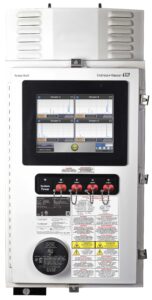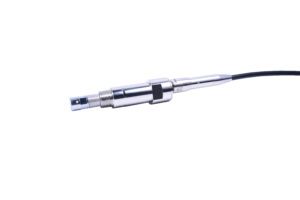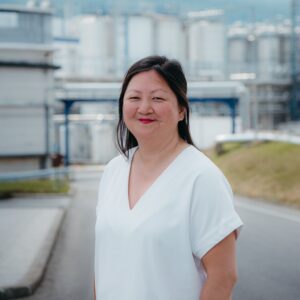The integration of Raman spectroscopy into “green” ammonia production represents a significant advancement in ensuring product quality and process efficiency
In the quest for sustainable and environmentally friendly industrial processes, the production of “green” ammonia has emerged as a critical innovation. It offers a promising alternative to traditional ammonia production methods that rely heavily on fossil fuels. The application of Raman spectroscopy in green ammonia production ensures quality control and process efficiency.
What is green ammonia?
Green ammonia refers to ammonia produced using renewable energy sources, such as wind, solar or hydropower. Unlike conventional methods that rely on natural gas or coal, green ammonia production focuses on minimizing carbon emissions and reducing environmental impact. The Haber-Bosch process is a well-established industrial method to produce ammonia (NH₃). The primary raw materials for the process are nitrogen (N₂) and hydrogen (H₂). The N₂ from the air separation unit is combined with the H₂ and reacted via the Haber-Bosch process in an ammonia conversion reactor.
Traditionally used for ammonia synthesis, this process is adapted to utilize hydrogen derived from water electrolysis powered by renewable energy. Some recent technologies utilize a solid oxide electrolysis cell to produce hydrogen and nitrogen from water and air, powered by renewable electricity and feeding existing plants.
In today’s energy landscape, green ammonia is emerging as a fast response largely driven by the high cost of hydrogen. The production of green ammonia becomes especially advantageous during periods when solar and wind energy generation results in negative electricity prices. During these times, both ammonia and methanol can be produced at highly competitive rates.
These periods of inexpensive, renewable energy generation are characterized by their rapid onset and short duration, requiring the development of fast or dynamic green ammonia installations. These systems are designed to quickly ramp up production in response to favorable electricity pricing, utilizing advanced control systems and real-time data analytics to optimize performance.
The synthesis loop in green ammonia production involves several critical steps, including the Haber-Bosch process, where nitrogen and hydrogen are combined under high pressure and temperature, with a catalyst, to produce ammonia. To maximize efficiency in this process, the measurements within the synthesis loop must be extremely fast and accurate. This includes monitoring parameters, such as temperature, pressure and gas composition in real-time.
Producing green ammonia presents several challenges. The process requires significant amounts of electricity, which can be a limiting factor in regions with less access to renewable energy. Additionally, the efficiency of electrolysis and the durability of the materials used in the process are critical factors that need continuous improvement.
However, while the shift to green ammonia supports the decarbonization of the chemical industry, it also advances the broader goal of achieving net-zero emissions. As a result, its global market is experiencing rapid growth.
In 2021, the ammonia market volume reached approximately 5,800 metric tons, rising from 3,700 metric tons in the previous year. This figure is expected to grow at a compound annual growth rate (CAGR) of 90%, reaching around 1.6 million metric tons by 2030. Additionally, the market size was valued at $151.57 million in 2022 and is projected to grow at a CAGR of 116.5% from 2023 to 2030.
Challenges in controlling the quality of ammonia
Ensuring the quality of ammonia is crucial for its various applications, including fertilizers, pharmaceuticals and industrial chemicals. The primary challenges in maintaining ammonia quality during the green production process include the following:
- Impurities: The presence of impurities such as oxygen, nitrogen oxides and other contaminants can compromise ammonia’s purity and performance.
- Process Variability: Fluctuations in renewable energy sources can cause inconsistencies in the production process, affecting the quality and stability of the final product.
- Real-time Monitoring: Traditional quality control methods often rely on offline sampling and laboratory analysis, which can be time-consuming and may not provide real-time insights into the production process.
The need for advanced measurement tools
To address these challenges, advanced measurement tools are required to ensure continuous monitoring and control of the ammonia production process. Key requirements for these tools include the following:
- Accuracy: Precise measurement of chemical composition and detection of impurities
- Real-time analysis: Capability to provide immediate feedback on process conditions and product quality
- Non-intrusive monitoring: Methods that do not interfere with the production process or require extensive sample preparation
Innovative process monitoring with Raman technology
To enhance the efficiency of ammonia production, Raman spectroscopy can be employed (Figure 1). This advanced solution continuously monitors production and compensates for inherent process fluctuations, minimizing maintenance needs. Raman spectroscopic systems can provide accurate measurements and faster response times compared to traditional gas chromatographs.

Figure 1. Raman spectroscopic analyzers, such as this one, provide quantitative chemical composition for gas measurements (photo credit: Endress+Hauser)
Raman spectroscopy is based on the inelastic scattering of light, known as Raman scattering. When light interacts with a molecule, it can scatter with a shift in energy corresponding to the vibrational modes of the molecule. This shift provides a molecular fingerprint that can be used to identify and quantify chemical species.
Raman spectroscopy can be employed to monitor the concentration of reactants and products in the production of green ammonia. The most critical measurement is the hydrogen-to-nitrogen ratio between the synthesis reactor and the compressor in the recycle stream. Raman spectroscopy is highly sensitive to homonuclear diatomic gases like hydrogen and nitrogen, which are key components in ammonia production.
The technology provides real-time, in-situ monitoring of the chemical composition of gas streams, allowing for immediate adjustments to optimize production. It can be installed at the reactor feed to control the H₂/N₂ ratio, in the synthesis loop recycle gas to verify the composition and impurities, and in the synthesis-loop purge gas.

Figure 2. A Raman spectroscopic probe provides reliable, quantitative gas-phase measurements in a process environment (photo credit: Endress+Hauser)
Raman spectroscopy is a non-invasive technique that does not require sample extraction or preparation (Figure 2), lowering the risk of contamination and ensuring highly accurate measurements. As a result, minimal maintenance is required, as it provides continuous monitoring and early detection of process fluctuations, reducing downtime.
In addition, by eliminating the need for consumables and sample transport, Raman technology can lead to significant cost savings compared to traditional analytical methods.
Final thoughts
The integration of Raman spectroscopy into the green ammonia production represents a significant advancement in ensuring product quality and process efficiency. By providing real-time, accurate and non-intrusive monitoring of H2 and N2 ratios, Raman spectroscopy addresses the key challenges in ammonia production and supports the transition to sustainable industrial practices. As the demand for green ammonia continues to grow, the adoption of advanced analytical tools like Raman spectroscopic systems will be crucial in achieving the goals of sustainability and environmental responsibility.
Raman spectroscopy is set to play a crucial role in the future of green ammonia production, helping to drive the industry towards greater efficiency, sustainability and environmental responsibility. ■
Edited by Dorothy Lozowski
Authors

Koen Roelstraete is an Oil & Gas business industry manager at Endress+Hauser (www.endress.com), where he drives strategic initiatives and solution development for process analytics in the energy sector. With over 30 years of experience in gas chromatography and process instrumentation, he supports customers across Europe in optimizing operations and ensuring compliance in complex industrial environments. Roelstraete holds an M.Sc. in chemical and bioscience engineering from Ghent University and is recognized for his deep technical expertise and commitment to advancing analytical technologies in oil & gas applications.
 Stefano Santarpia is a business industry manager at Endress+Hauser, where he leads the development and implementation of Optical Analysis Solutions in the New Energies sector. His primary focus is on supporting industrial stakeholders in achieving decarbonization goals through technological innovation in renewable natural gas (RNG), carbon capture and storage (CCS) and hydrogen value chains. He holds both a B.S. and an M.Eng. in environmental engineering from the University of Naples “Federico II” (2012), and is currently enrolled in the Executive MBA program at the Graduate School of Management, Politecnico di Milano. Santarpia is an active member of the European Biogas Association and contributes to several technical task forces within the Biomethane Industrial Partnership, promoting policy and technology alignment across the biomethane ecosystem.
Stefano Santarpia is a business industry manager at Endress+Hauser, where he leads the development and implementation of Optical Analysis Solutions in the New Energies sector. His primary focus is on supporting industrial stakeholders in achieving decarbonization goals through technological innovation in renewable natural gas (RNG), carbon capture and storage (CCS) and hydrogen value chains. He holds both a B.S. and an M.Eng. in environmental engineering from the University of Naples “Federico II” (2012), and is currently enrolled in the Executive MBA program at the Graduate School of Management, Politecnico di Milano. Santarpia is an active member of the European Biogas Association and contributes to several technical task forces within the Biomethane Industrial Partnership, promoting policy and technology alignment across the biomethane ecosystem.
 Laure Aimoz is a marketing manager at Endress+Hauser, where she specializes in optical analysis solutions for the oil and gas, energy, chemical and life sciences industries. She earned her Ph.D. degree in geochemistry from the Paul Scherrer Institute and the University of Bern in Switzerland. Additionally, she holds an executive MBA from EM Lyon Business School in France, an M.Sc. in environmental analytical chemistry from University College Cork in Ireland, and an M.Eng. from INP Toulouse-ENSIACET in France. Aimoz is dedicated to integrating analytical instruments, such as spectrometers and chromatographs, into industrial process applications. She combines strong business acumen with a skill for making science accessible to a broader audience.
Laure Aimoz is a marketing manager at Endress+Hauser, where she specializes in optical analysis solutions for the oil and gas, energy, chemical and life sciences industries. She earned her Ph.D. degree in geochemistry from the Paul Scherrer Institute and the University of Bern in Switzerland. Additionally, she holds an executive MBA from EM Lyon Business School in France, an M.Sc. in environmental analytical chemistry from University College Cork in Ireland, and an M.Eng. from INP Toulouse-ENSIACET in France. Aimoz is dedicated to integrating analytical instruments, such as spectrometers and chromatographs, into industrial process applications. She combines strong business acumen with a skill for making science accessible to a broader audience.